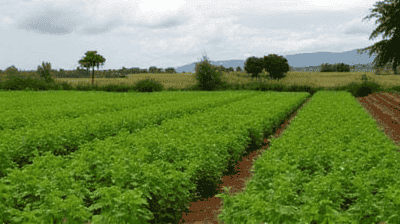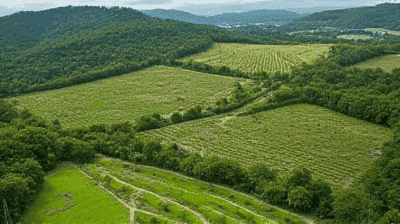
As the global population continues to rise, the demand for food skyrockets, putting immense pressure on agricultural systems worldwide. Conventional farming practices often lead to soil degradation, loss of biodiversity, and increased greenhouse gas emissions. However, innovative approaches like agrorestoration are gaining attention for their potential to restore ecosystems while enhancing agricultural productivity. One of the cornerstones of agrorestoration is the integration of trees into farmland, an aspect often overlooked in traditional agricultural practices.
Agrorestoration refers to the process of restoring degraded agricultural landscapes to increase their productivity and ecological value. This approach focuses on revitalizing ecosystems while improving agricultural output through practices that enhance biodiversity, soil health, and resilience against climate change.
Ecosystem services are the benefits that humans derive from natural ecosystems. They can be categorized into four main types:
Provisioning Services: These include the production of food, water, and raw materials.
Regulating Services: These services help regulate climate, water quality, and disease.
Cultural Services: These encompass non-material benefits, such as recreation and cultural heritage.
Supporting Services: These are necessary for the production of all other ecosystem services and include processes like soil formation and nutrient cycling.
Incorporating trees on farms enhances these ecosystem services, providing farmers with numerous benefits alongside traditional crop production.

Trees serve as vital habitats for a multitude of species. They provide nesting sites, food sources, and shelter for birds, insects, and other wildlife. By increasing habitat complexity, trees contribute to greater species diversity on farms.
Many fruit and vegetable crops rely on pollinators for successful reproduction. Trees, especially flowering species, attract bees, butterflies, and other pollinators, ultimately boosting crop yields through improved pollination.
Diversifying plant life by integrating trees can also suppress pest populations naturally. Trees can host beneficial insects, such as ladybugs and predatory wasps, which feed on crop-damaging pests. This natural pest management reduces the need for chemical pesticides and enhances crop resilience.
Trees contribute significantly to nutrient cycling on farms. Their deep root systems access nutrients unavailable to shallow-rooted crops, helping to replenish soil fertility when leaves and organic matter decompose.
The root systems of trees prevent soil erosion by stabilizing the soil and reducing surface runoff. This is particularly important on sloped or degraded lands where erosion can strip away valuable topsoil.
Healthy trees support a diverse microbial community in the soil. The organic matter produced by trees nourishes soil microbes, which play a crucial role in nutrient cycling and overall soil health. This increases soil fertility and enhances water retention, creating a more productive farming environment.
Trees improve water retention in the soil through their root systems, which create channels for water infiltration. Additionally, trees reduce evaporation rates by providing shade and increasing humidity around crops. This is particularly beneficial in areas facing water scarcity.
By providing shade and reducing wind speeds, trees create favorable microclimates on farms. This can lead to improved growing conditions for crops, especially in regions with extreme temperatures or unpredictable weather patterns.
Integrating trees into agricultural systems can offer farmers additional sources of income. This includes timber, fruits, nuts, and other non-timber forest products. Diversification reduces dependence on a single crop and enhances the farm's economic resilience.
Research shows that the presence of trees can lead to increased crop yields. Trees provide various benefits, such as shade and protection from wind, which can enhance the growth and survival rates of crops. Studies have demonstrated that agroforestry systems can yield up to 30% more than conventional monoculture practices.
Agroforestry is an integrated approach that combines agriculture and forestry to create diverse and productive land-use systems. There are several types of agroforestry systems:
Silvopasture integrates trees, pasture, and livestock. This system provides shade for animals, improving their welfare and productivity while enhancing soil health and biodiversity.
In alley cropping, rows of trees are planted alongside rows of crops. This design maximizes land use by allowing crops to grow in the spaces between trees while benefiting from the ecosystem services that trees provide.
Forest farming involves cultivating crops under a forest canopy, combining tree production with understory crops. This method utilizes the shade produced by trees to create microclimates suitable for certain types of crops, such as medicinal herbs and shade-tolerant vegetables.
Choosing the right tree species is crucial for the success of agrorestoration efforts. Farmers should consider:
Native Species: Native trees often have better adaptability and resilience to local conditions while supporting existing wildlife.
Multipurpose Trees: Species that provide multiple benefits, such as fruit, timber, and fodder, can enhance both agricultural and economic output.
Soil Improvement: Some tree species, like legumes, can fix nitrogen in the soil, enriching it and benefiting adjacent crops.

The Loess Plateau in China has experienced severe soil erosion and degradation. In response, agrorestoration initiatives have been implemented, focusing on reforesting sloped lands with native trees. These initiatives have resulted in increased soil stability, improved water retention, and enhanced agricultural productivity. Farmers engaged in these restoration efforts have reported increased crop yields and improved quality of life.
In the Sahel region, farmers have embraced agroforestry practices, such as parkland systems that combine trees and crops. This approach helps combat desertification while improving soil health and biodiversity. The integration of trees has led to increased agricultural resilience against climate variability, enhancing food security in this arid landscape.
Brazil's Atlantic Forest has suffered significant deforestation, impacting biodiversity and agricultural systems. Initiatives have focused on reintroducing native tree species alongside agricultural production. By restoring this landscape, farmers have not only improved soil health and water quality but also gained access to alternative income sources through the sale of forest products.
Agrorestoration, particularly through tree integration, plays a significant role in climate change mitigation. Trees sequester carbon dioxide, reducing greenhouse gas concentrations in the atmosphere. Furthermore, improved soil health and biodiversity enhance the resilience of agricultural systems against climate impacts.
Agrorestoration contributes to the conservation of biodiversity by creating habitats for various species, from pollinators to larger wildlife. Maintaining ecosystems on farmland is crucial for preserving genetic diversity and ensuring the viability of future crops.
As agricultural landscapes are restored through agrorestoration practices, overall food security and nutrition can improve. Diverse farming systems enhance the availability of a wide range of nutritious crops, positively impacting public health.
Agrorestoration initiatives require collaboration among farmers, local communities, and environmental organizations. Engaging communities in restoration efforts fosters a sense of stewardship and responsibility for local ecosystems, promoting resilience and adaptive capacity in the face of environmental and social challenges.

A key barrier to implementing agrorestoration practices is the lack of knowledge among farmers regarding tree integration and the benefits it provides. Educational outreach and training are essential for equipping farmers with the necessary skills and information.
While agrorestoration can lead to increased productivity and income in the long run, the initial costs associated with planting and maintaining trees can be a deterrent for some farmers. Financial support, incentives, and access to resources are essential to help farmers overcome these barriers.
In some regions, competition for land use can impede agrorestoration efforts. Balancing the needs of agriculture, forestry, and conservation requires careful planning and policy support.
Climate change poses significant challenges to agrorestoration, as shifting weather patterns can affect species selection and the success of restoration efforts. Adaptive management strategies are necessary to address these uncertainties.
Government policies that support agrorestoration through funding, technical assistance, and training programs are essential for promoting tree integration on farms. Establishing clear guidelines and incentives will encourage farmers to adopt these practices.
Continued research into the benefits and best practices of agrorestoration is vital for developing effective strategies that meet the needs of diverse agricultural systems. Innovations in agroforestry techniques, tree breeding, and ecosystem management will enhance the viability of agrorestoration efforts.
Empowering local communities to take charge of agrorestoration initiatives ensures that practices are context-specific and culturally appropriate. Community-led projects that integrate traditional knowledge with scientific approaches will strengthen the effectiveness of restoration efforts.
Agrorestoration is a global challenge that requires international collaboration and knowledge exchange. Sharing successful case studies, research findings, and best practices from various regions can foster a collective effort to restore agricultural landscapes worldwide.
Agrorestoration represents a transformative approach to agriculture that prioritizes biodiversity, soil health, and sustainable yields. Trees play a pivotal role in this system, enhancing ecosystem services while supporting farmers' productivity and resilience. By integrating trees into agricultural practices, we can address pressing challenges such as climate change, food security, and biodiversity loss.
As we move toward a more sustainable future, embracing agrorestoration principles and practices will be essential for securing the health of our planet and its inhabitants. Through collaboration, education, and innovation, farmers can become stewards of both the land and its ecosystems, cultivating a thriving, sustainable agricultural landscape for generations to come.